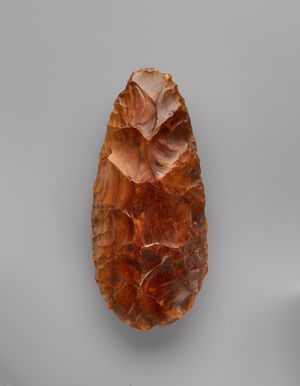
(p. C14) From the beginning, the purpose of the Masterpiece column has been to highlight artworks of surpassing cultural significance and discuss the particular qualities that make them so. How, then, to explain the intrusion into this august company of a utilitarian object, in this case a biface, or hand axe, dated 700,000-200,000 B.C.?
Behind the creative impulse is the aesthetic sense, the desire to make something beautiful, or at least pleasing to the eye. For almost all of human history, utilitarian objects, by contrast, were all about practicality, crafting something that can get the job done. Never the twain shall meet.
Two factors, though, suggest that here the dividing line might not be crystal clear. The first is the biface’s location, not in a natural history museum where they are usually to be found, but the Metropolitan Museum, a repository of art.
The second is its label. “This is one of the largest and most finely crafted bifaces found in France,” we are told. “Its size and the care with which it was made raise the question of whether it was meant to be a tool, or if it was chiefly valued for its appearance and reserved for a different use.”
. . .
From a broadly rounded bottom the two sides flare out then turn inward, ever so gradually tapering to a rounded point that mirrors the bottom edge in miniature. Its changes in depth are equally subtle and well-calibrated, maintaining a uniform thickness along its length and slowly thinning to a shallow wedge starting about three quarters of the way up.
Then there is the material. Flint comes in many colors. The rich caramel hue of this one, lighter in spots than others, may be what caught the eye of our anonymous artisan in the first place. It has veining, too, which likewise seems to have been an attraction, since its curves are echoed by the adjacent edge of the stone.
For the full commentary, see:
Eric Gibson. “The Dawn of Aesthetics.” The Wall Street Journal (Saturday, July 10, 2021): C14.
(Note: ellipsis added.)
(Note: the online version of the commentary has the date July 9, 2021, and has the same title as the print version.)

